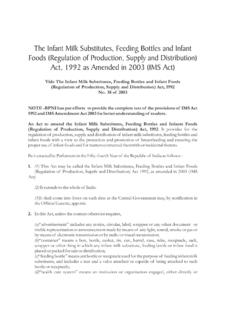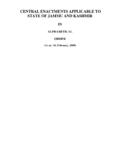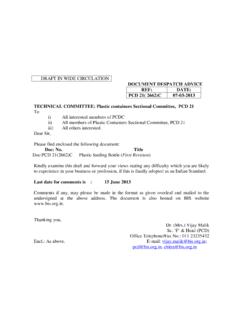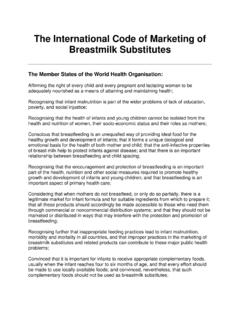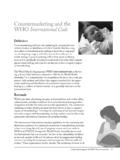Transcription of Certified Lactation Counselor Academic Content …
1 1 Certified Lactation Counselor Academic Content Checklist You must also provide proof of completion of the course(s). Please attach certificate(s) or transcripts to this checklist. Title of Education Program that Covered Each Bullet Point A. Hormonal Influences in Pregnancy and Lactation National and international recommendations for breastfeeding duration Definitions of patterns of breastfeeding. Stages of lactogenesis Normal changes in milk composition Normal feeding behaviors of breastfeeding babies and children from birth through weaning Labor and delivery routines and their relationship to breastfeeding outcomes Growth patterns of breastfed infants compared to formula fed Physical, behavioral and developmental reasons to encourage long term breastfeeding for mother and baby Lactation and Fertility (Lactational Amenorrhea Method (LAM)) hormonal and barrier methods and breastfeeding B.
2 Maternal and infant Nutrition Optimal nutritional and fluid intakes for breastfeeding mothers Impact of maternal diet and nutritional status on the milk and the baby Optimal human milk intakes C. Latch-on and Positioning for Breastfeeding Strategies that optimize latch, positioning and milk transfer D. Nipple and Breast Problems Standards of nipple and breast care for breastfeeding mothers and babies Strategies for coping with common problems 2 E. milk Supply The body s normal function of producing and delivering milk including the role of hormones infant anatomy and physiology related to suckling and swallowing Methods of determining milk intake Strategies for building and maintaining an optimal milk supply Common reasons and management strategies for oversupply of milk and forceful let-down F.
3 Commercial Products Possible impact of feeding related devices on mother, baby and/or breastfeeding G. Weaning Natural process of weaning H. Special Circumstances of Mother or infant Maintaining breastfeeding when mother and baby are separated II. Human Anatomy and Physiology in Relation to Lactation Complex Situations Title of Education Program that Covered Each Bullet Point A. Hormonal Influences in Pregnancy and Lactation Accepted contraindications to breastfeeding published by governmental authorities Commonly encountered problems of mother and baby causes, prevention and management Resources for information about the effect of drugs.
4 Herbs and medications on breastfeeding Relationship between postpartum mood disorders and breastfeeding Referral criteria for breastfeeding problems of the infant or mother Collection and storage of breast milk Anthropometric measures related to insufficient growth in breastfed infants and young children Health consequences of short-term or no breastfeeding for mother and infant Factors that increase complexity of mother s or infant s ability to breastfeed long term 3 B. Maternal and infant Nutrition Effect of commonly used drugs, medications and herbal remedies on milk quantity and quality Maternal dietary components that may provoke reactions in the breastfed infant C.
5 Nipple and Breast Problems Identification of nipple and breast challenges to breastfeeding Criteria for referral Management of nipple and breast problems common to breastfeeding mothers D. Latch-on and Positioning for Breastfeeding Identification of sub-optimal latch-on and positioning Positions suitable for breastfeeding with babies/mothers who have challenges to breastfeeding Compensation strategies for babies/mothers with sub-optimal latch or positioning E. Supplementation of the Breast milk Fed Baby Safe formula feeding Economics of breast and formula feeding Signs and symptoms of atopy and food intolerance Common reasons and management strategies for inadequate milk production Common reasons and management strategies for inadequate milk transfer Strategies that increase and maintain milk supply under difficult circumstances, including relactation, during separation of mother and baby Accepted criterion for supplementation of breastfed infants.
6 (WHO, UNICEF, AAP) Wet-nursing, informal sharing, and donor milk banking F. Commercial Products Appropriate use of commercial products in complex breastfeeding situations ( pumps, supplementers, bottles, feeding devices, pacifiers, etc.) G. Weaning Hallmarks and management of nursing strike. Indications for an management strategies for maintaining and increasing milk supply under difficult circumstances such as with multiples and during separation (employment, hospitalization, relactation) Management strategies for reluctant nursers. 4 H. Special Circumstances of Mother or infant Management strategies for mothers and infants with diagnosed physical or developmental challenges to breastfeeding ( for infants: prematurity, cleft-lip and palate, Down Syndrome) ( for mothers, breast surgery, inadequate breast tissue, medical conditions) III.
7 Successful Breastfeeding Management Programs Title of Education Program that Covered Each Bullet Point The WHO/UNICEF Baby-Friendly Hospital Initiative The Ten Steps to Successful Breastfeeding including the implementation of the WHO/UNICEF Baby-Friendly Hospital Initiative in the United States Strategies for Promotion, Protection and, Support of breastfeeding and human Lactation including features of programs that demonstrate breastfeeding promotion, protection and support III. Counseling Techniques Title of Education Program that Covered Each Bullet Point A. Knowledge of The Counseling Process Commonly encountered barriers to breastfeeding and counseling strategies to address them Communication techniques that serve to enhance a mother s confidence in her ability to breastfeed Adjuncts to the counseling process -- as eye-contact, body-language and judgmental versus non-judgmental language.
8 Characteristics of five learning styles of women and teaching/counseling strategies for each Using the counseling process with breastfeeding mothers in a variety of circumstances Providing appropriate anticipatory guidance and proactive support Counseling and providing anticipatory guidance that incorporates and respects the value systems and health beliefs of the breastfeeding mother Evaluation of personal and peer effectiveness of counseling sessions 5 IV. Public Health and Breastfeeding Title of Education Program that Covered Each Bullet Point National goals for breastfeeding National breastfeeding campaigns National/state and local breastfeeding laws, rules and regulations such as those related to employment The effect of hospital policies on milk supply and formula supplementation of babies in the hospital Violations of the International Code of Marketing of Breast milk Substitutes V.
9 Professional Ethics and Behavior Title of Education Program that Covered Each Bullet Point A. Knowledge of Scope of practice Appropriate utilization (consultation/referral) Professional continuing education responsibilities Ethical challenges specific to Lactation counseling Recognizing individual roles and responsibilities within appropriate scope of practice and referring appropriately My signature attests that the educational courses submitted covered every topic on this checklist. I understand that if a course review determines that any of these topics were not covered by the Academic work submitted by the applicant, I will not be eligible to sit for the Certified Lactation Counselor Exam.
10 Name (print) _____ Signature_____ Date_____

